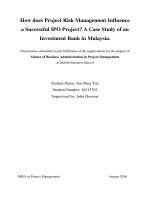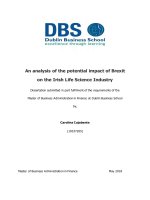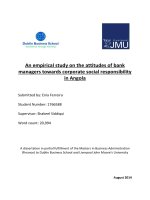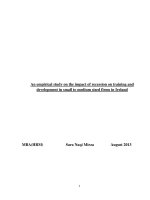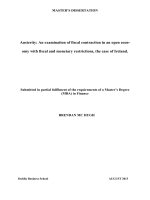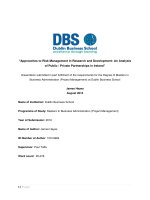Master Thesis in Economics “An analysis of the effectiveness of government R&D policies on business R&D expenditure” doc
Bạn đang xem bản rút gọn của tài liệu. Xem và tải ngay bản đầy đủ của tài liệu tại đây (731.53 KB, 42 trang )
The Royal Institute of Technology
Master’s program in Economics of Innovation and Growth
(Professor Stefan Fölster)
Master Thesis in Economics
“An analysis of the effectiveness of
government R&D policies on business
R&D expenditure”
Written by
Kaifeng Li ()
June 2010
II
ABSTRACT
This thesis investigates the effectiveness of government R&D policies in 13 OECD
countries from 1985 to 2007. R&D plays an important role in the world economy, and
business-funded R&D accounts for the majority in total R&D spending.
Policy-makers design various R&D policies to stimulate business R&D expenditure.
Since the existence of R&D policies, researchers highly contributed their enthusiasm
on the analysis of the efficiency of those R&D policies, but the validity of
government intervention still received considerable controversy. Thereby, the purpose
of this thesis is tried to follow the historical arguments and investigates the
effectiveness of government R&D policies on business-funded R&D. Three questions
are mainly addressed: Does the leverage effect of public funding on business R&D
really exist? How those different policy instruments do influence firms’ R&D
behavior? How do those policy instruments interact with each other? The thesis
searched the answers for the three questions, and concluded that the optimal policy
tool for government to stimulate private R&D is tax incentives, and government
cannot affect much to firms’ R&D investment decisions.
Key words: Business-funded R&D, government funding of R&D performed in
business, tax incentive, government research, university research, crowding-out effect,
crowding-in effect.
III
ACKNOWLEDGEMENTS
I would like to express my gratitude to my supervisor Professor Stefan Fölster for the
valuable guidance, the precious help, and the constructive advices he provided to me
during the entire process.
Special thanks go to the Professor Hans Lööf for the data analysis guidance, without
his generous support and unlimited patience, it is surely that I cannot go this far.
I would also like to thank Professor Kristina Nyström for the grammar checking and
constructive suggestions, I am sincerely appreciated to her kindness.
At last, I would like to show my deepest gratitude to my mom, whom extremely
eliminates my pressure with her love, and her tough support strongly encouraged my
thesis working.
In a word, I would like to extend my sincere gratitude to everyone for kind helps.
IV
Table of Contents
ABSTRACT II
ACKNOWLEDGEMENTS III
1. INTRODUCTION 1
2. THE THEORETICAL BACKGROUND 3
3. EMPIRICAL LITERATURE REVIEW 7
3.1 Empirical Literature Studies on Tax Incentives 7
3.2 Empirical Literature Studies on Government Direct Financial Support 9
3.3 Empirical Literature Studies on Public Research 12
4. ECONOMIC BACKGROUND 13
4.1 Trends of R&D Expenditure 14
4.2 Tax Concessions 15
4.3 Changes of Government R&D Budget 16
5. DATA AND METHODOLOGY 18
6. EMPIRICAL RESULTS 20
7. CONCLUDING REMARKS 27
8. REFERENCE 30
9. APPENDIX 32
A. The B-Index 32
B. Tax subsidy rate for USD 1 of R&D, large firms and SMEs, 2008 35
C. Trends of B-index from 1985 to 2007 35
D. The Effectiveness of R&D Policy Tools on Business-funded R&D in Country level
analysis 36
E. The Interaction between Various R&D Policy Tools in Country-level Analysis 37
1
1. INTRODUCTION
In the past few decades, the importance of technical change has received
increasing attention both from researchers and policymakers, because of the
change stimulate a country’s long-run rate of economic growth. A key factor
dominating technical change is that the knowledge accumulation through
expenditure on research and development (Becker and Pain, 2003). In 1994, R&D
was defined by Frascati Manual as “Research and experimental development
(R&D) comprise creative work undertaken on a systematic basis in order to
increase the stock of knowledge, including knowledge of man, culture and society
and the use of this stock of knowledge to devise new applications”. Despite the
recognition of the importance attached to R&D now for long-run economic
growth and living standards, it is commonly argued that social optimal R&D level
cannot be reached without government intervention. Schumpeter (1942), Nelson
(1959) and Arrow (1962) firstly argued the rationale of government R&D
intervention. They hold such a conceptual idea that knowledge is non-rival good.
Therefore, the private return on R&D investment will hardly be appropriated,
which leads to an under-provision of R&D investment in the economy (Lööf and
Hesmati, 2004). Guellec and van Pottelsberghe (2000) argued that imperfect
appropriability and diffusion of knowledge uncontrolled caused innovators cannot
fully appropriate the benefits of their innovations, which implied that the rate of
private return to R&D is lower than its social return. Becker and Pain (2003)
emphasized that market failures can provide a rational for government
intervention to support private R&D. They mentioned that the expenditure on
R&D should be lower than social optimal level if the private rate of return is
lower than social rate of return, and if firms experience the significant external
financial constrains, the R&D expenditure will also be lower than social optimal
level. Streicher, Schibany and Gretzmacher (2004) claimed that pure markets will
not be efficient in stimulating innovation due to the inherent characteristics of
2
R&D. “In most situations the market will fail to provide sufficient incentives to
invest in R&D since firms face appropriability problems. The reason is that R&D
has some characteristics of a public good, so that the private returns on innovation
will be lower than its social return”.
Since the government R&D policy performed, lots of researchers have been
contributed their effort to the evidence searching of the effectiveness of
government intervention. Although most of them observed positive effects in this
field, but the validity of government intervention still received considerable
controversy. Some researchers argued that the existing econometric evidence of
the substitutability or complementarity effects of public R&D funding is very
inconclusive (Becker and Pain (2003), David, Hall and Toole (1999)). I wish this
thesis will contribute about new implications and evidence to the current
literature.
The purpose of this thesis is try to follow the historical arguments and investigates
the effectiveness of government R&D policies on business-funded R&D in OECD
countries from 1985 to 2007. However, because of the limitation of data collection,
only 13 OECD countries have been found that can qualified the thesis’
observation period requirement, which those OECD countries are United States,
United Kingdom, France, Italy, German, Japan, Spain, Ireland, Belgium, Portugal,
Denmark, Finland, and the Netherlands. In the thesis, three questions are mainly
addressed: Does the leverage effect of public funding on business R&D really
exist? How do those different policy instruments affect firms’ R&D expenditure
behavior? Do those policy instruments interact with each other? The analysis in
this thesis implements a previous analytical model published by Gullec and van
Pottelsberghe (2000). From my best knowledge, they are the only researchers
whom organized all categories of government R&D policy tools within a single
analytical model, which eliminate comparison issues by the heterogeneity of the
empirical models used. Besides, they also got reasonable results. However, in
3
contrast to their analysis, this thesis implemented more advanced regression
technique and extended the analysis area to provide more details with
country-level studies. The observation period is also ten years longer than Gullec
and van Pottelsberghe’s analysis.
The remaining part of this thesis is structured as follows: The next section will
provide the theoretical background, and section 3 reviews the empirical literature
of the effectiveness of R&D policies. In section 4, the thesis will introduce the
economic background of the 13 OECD countries. Moreover, in the following two
sections, this thesis will describe the data set and the analytical model, and state
the empirical results. The final conclusion will be provided in the section 7.
2. THE THEORETICAL BACKGROUND
Historically, there are various policy tools available for government to stimulate
business-funded R&D. The empirical literature summarizes those policy tools into
three main categories:
Firstly, government can encourage business R&D activities through favorable tax
treatment. The R&D tax may increase R&D that is marginally profitable for the
firm, but only if the elasticity of R&D with respect to costs is high. Government
implements this policy tool to decrease firms’ R&D risk through tax breaks based
on the level of R&D expenditure. Currently, there are many forms of tax treatment
of R&D, like accelerated depreciation of investment, tax credit. In contrast to the
other R&D policy tools, this one is more transparent, and this policy tool is a more
market-oriented approach. The policy tool leaves decisions on the level and timing
of R&D expenditure to the private sector, and meanwhile, it gives a government
the option to pay for R&D that is otherwise not profitable at all for the firm, but
may be socially worthwhile. Guellec and van Pottelsberghe (2000) argued that tax
concessions were not conditional on the type of recipient’s R&D performance.
4
Therefore, tax incentives will not affect the R&D composition.
Secondly, government can directly fund business R&D through granting or/and
procuring private R&D projects. The previous mentioned Frascati Manual
identified that the government direct funds to business R&D into two categories,
one is specifically for procurements of R&D (the R&D result is government
property). The other category is that government commits grants or subsidies to
the R&D performer (the R&D results belong to the recipient). Yong (1998) argued
that government procurements, grants, and fiscal incentives account for the bulk
of government support to business R&D. In this category, the government funds
will be purposed for the specific technical projects which seem to have higher rate
of social return. Public investors wish that additional research projects will take
place in contrast to the ones that would have been done without the public support
through the performance of this policy tool. Although the government funded
R&D and performed by business primarily includes procurement and grants, it is
worth to remind that some other forms of direct R&D support still exist, like loan
guarantees, conditional loans, and convertible loans.
At last, through funding public research (public laboratories and universities)
government may indirectly support private R&D. Due to the main purpose of
public institutions is generating basic knowledge to meet public needs. But the
knowledge may directly employ by private firms to improve their private return
on R&D investment. Besides, basic research may also open new opportunities to
business research, which in turn affects productivity. Hence, this policy has a
possibility to trigger higher business R&D expenditures through technology
spillover effects.
When government commits their funds with the purpose to encourage private
R&D expenditures, they may aim directly to fund business R&D through granting
or/and procuring private R&D projects to reduce the private R&D cost, or
5
indirectly to support private R&D by providing technological opportunities
available to firms. If those policies works well, then public and private funding
will be complementary, which means increase the intensity of one will enhance
the other. However, empirically, those policy tools have been challenged by four
main grounds: full crowding-out effect, partial crowing-out effect, no influence,
and allocative distortion. Streicher, Schibany and Gretzmacher (2004) argued that
R&D expenditure and the reaction of R&D subsidies were the result of firms’
internal decisions. Therefore, government policy tools cannot (or only partially)
influence private R&D directly. The figure 1 is used to graphically describe part of
the five main effects on public support to business-funded R&D.
Figure 1. The effects of R&D subsidies on total R&D expenditures
(Source: Input Additionality Effects of R&D Subsidies in Austria. 2004)
Firstly, for crowding-out effects, the full crowding-out effects implies firms may
use government money as “windfall gains”. They just use that money simply to
substitute their own spending. Moreover, government spending may increase the
cost of R&D to crowd out private money. Goolsbee (1998) and David and Hall
6
(1999) both had been observed that government funding significantly raised the
wage of researchers. For instance, government funding may increase the salary of
researchers, although the total amount of R&D costs looks higher, but nothing
actually changes, and the real amount of R&D may be even lower than before.
The partial crowding-out effect means that firms may raise their R&D expenditure,
but less than the amount of government support.
Secondly, public support has no influences on private R&D occurs when firms
maintain the level of their R&D expenditures, but by use of full amount of the
subsidy extends total research. Because of firms would like to do more R&D than
they can afford to enhance their advantage in market, but banks are reluctant to
provide financial support.
Thirdly, the crowding-in effect reflects the stimulating effect of public support on
private R&D expenditure, which means with one unit of public R&D spending
will induce higher amount of business R&D expenditure than government
support.
In the empirical literatures, some authors use “substitutability” to imply
crowding-out effect, and taken “complementarity” to imply crowding-in effect.
Like David, Hall and Toole (1999).
At last, the reasons of inducing allocative distortions is that government funds
allocated to a project in the less efficient way than market force will do. If
government funding is directed towards those projects that firms will undertake
anyway, thus this will leads to a misallocation of resources. Furthermore, in the
imperfect market, when government provides their financial assistance to a firm,
government may help the recipient even it is initially inferior to alternatives.
7
3. EMPIRICAL LITERATURE REVIEW
In this section, the paper will review the empirical results for the effectiveness of
government R&D policy instruments. The serves at empirical literature shows that
previous studies applied various dataset, observation period and testing
methodology, but most of studies have demonstrated positive evidence of public
intervention.
3.1 Empirical Literature Studies on Tax Incentives
Hall (1992) used firm-level R&D spending data to evaluate the impacts of
R&D tax policy on manufacturing firms’ R&D investment in the United
States during 1980s. She estimated average tax price elasticity for R&D
spending which is in the neighborhood of unity in the short run, and
concluded the existence of positive relationship between tax credits and
private R&D spending. The author also argued that the R&D tax credits had
the intended effect, and although the high correlation over time of R&D
spending at the firm level makes it difficult to estimate long run effects
precisely, but the same high correlation makes it probable that these effects
are large. McCutcheon (1993) analyzed the response of the strategic groups
in the pharmaceutical industry to the credit. He formed four strategic groups
using different levels of research intensity and relative cash flow margin, and
concluded that tax credits stimulated firms’ competitive R&D expenditures in
the pharmaceutical industry. The author contended that a 1.6% R&D increase
was attributable to the credit. Hall and Van Reenen (1999) argued that the
effectiveness of fiscal incentives for R&D based on the tax system in OECD
countries on the user cost of R&D, and they concluded that a dollar in tax
credit for R&D stimulated a dollar of additional R&D. Bloom, Griffith and
Reenen (2000) examined the impact of fiscal incentives on the level of R&D
investment with an econometric model of R&D investment. They used a
8
panel of data on tax changes and R&D spending in 9 OECD countries from
1979 to 1996. They concluded that tax incentives were effective in increasing
R&D intensity. This is true even after allowing for permanent country
specific characteristics, world macro shocks and other policy influences.
They concluded that a 10% fall in the cost of R&D stimulates just over a 1%
rise in the level of R&D in the short-run, and just under a 10% rise in R&D
in the long-run. Guellec and van Pottelsberghe (2000) used a first-difference
auto-regressive model to analyze a panel data which collected from 17
OECD countries over 1983-1996. They concluded that tax incentives have
positive effect on business-financed R&D, The short-term (long-term) private
R&D elasticities is -0.29 (-0.33) for tax incentives. Mulkay and Mairesse
(2003) analyzed the effectiveness of tax credits in France, which the credits
have been in place since 1983. The data in French companies from 1980 to
1997 is used to test an error correction model for R&D expenditure with a
user cost of R&D capital including this incremental tax credit. They
concluded that the R&D tax credit had a large significant and positive effect
on the optimal R&D capital. If the rate of the current tax credits is raised by
10% the optimal stock of R&D capital will increase by 4.6% to 6%, which is
far from being negligible. The summary of the empirical literature of the
effectiveness of fiscal incentives on private financed R&D displays in the
table 1
Table 1: Recent studies on the impact of fiscal incentives
Year
Data and type
Author(s)
Results
1992
U.S.
manufacturing
firms data
Firm level
Hall
The amount of additional R&D
spending induced was greater than
the cost in foregone tax revenue,
although the effective credit rate is
less than five percent until 1990.
1993
U.S.
pharmaceutical
industry data
Firm level
McCutcheon
Tax credits stimulated firms’
competitive R&D expenditures, and
a 1.6% R&D increase was
attributable to the credit.
9
1999
26 OECD
countries’ data
Country level
Hall and Van
Reenen
A dollar in tax credit for R&D
stimulated a dollar of additional
R&D.
2000
9 OECD
countries data
Country level
Bloom,
Griffith and
Van Reenen
Tax incentives were effective in
increasing R&D intensity. A 10%
fall in the cost of R&D stimulates
just over a 1% rise in the level of
R&D in the short-run, and just
under a 10% rise in R&D in the
long-run.
2000
17 OECD
countries’ data
Country level
Guellec and
Van
Pottelsberghe
Tax breaks has a positive impact on
business spending in R&D. The
short-term (long-term) private R&D
elasticities is -0.29 (-0.33) for tax
incentives.
2003
France data
Firm level
Mulkay and
Mairesse
R&D tax credit had a large
significant and positive effect on the
optimal R&D capital. If the rate of
the current tax credits is raised by
10% the optimal stock of R&D
capital will increase by 4.6% to 6%.
3.2 Empirical Literature Studies on Government Direct Financial Support
For the government direct financial support, Guellec and van Pottelsberghe
(2000) had also estimated it in their paper. They argued that Direct
government funding of business R&D has a positive impact on business
financed R&D. One dollar give to firms results in 1.70 dollars of private
research. However, the stimulating effect will increases up to a certain
threshold and then decreases beyond, which the threshold is about 13% of
business R&D. Becker and Pain (2003) estimated an econometric model of
R&D expenditure to analyze a panel of UK manufacturing industries. Their
results highlighted the importance of industry characteristics, and they found
that government funding appeared to play an important role on the total
industry R&D expenditures. 1 percentage point in the share of business R&D
expenditure funded by the government is estimated to raise the level of R&D
10
expenditure by 1.8%. Streicher, Schibany and Gretzmacher (2004) argued
that leverage effect of public subsidies to private R&D based on firm-level
data from the Austrian Industrial Research Promotion Fund. They concluded
that the public subsidies to private R&D have a crowding-in effect. With 1
additional euro of funding will induce firms to contribute an additional 40
cents of their own money. They also mentioned that very small and large
firms seem to exhibit higher leverage effect, but small and medium-sized
firms appeared to have smaller leverage effect. Lööf and Hesmati (2004)
investigated the effectiveness of a public innovation policy aimed at
stimulating private R&D investment at firm level. However, their result is
somewhat difference. They used the data from the Community Innovation
Survey (CIS) III for Sweden, and evaluated whether firms receiving public
funds have a higher R&D intensity on average compared to those not
receiving any such support. They concluded that there were additive effects
of public R&D financing on private research expenditure, but only for small
firms. Benavente (2003) compared and analyzed the Chilean manufacturing
firms under a situation that whether firms received or did not receive R&D
subsidies from 1995 to 1998. The author found a positive relationship
between public funding and private R&D. There was a 0.3 dollars
crowding-in effect in R&D spending in firms that received public funding.
The firms that received public R&D funding had higher R&D spending than
those corresponding firms without public R&D support. Besides, Einiö (2009)
identified of the causal effect of government support on private R&D effort
from a very different viewpoint compared with previous literature. The
author’s analysis is based on regional differences in eligibility for European
Union Regional Development Funds (ERDF) which determined by the
population-density rule, and the data is constructed by linking a broad R&D
survey to administrative data on all R&D support applications in Finland
from 2000 to 2006. He concluded that the support program had induced
additional private R&D expenditures among the participants who entered it
11
as a result of higher funding in their region, and among this group one
subsidy euro induced additional R&D worth at least 1.5 euro. However,
Wallsten (2000) found counterfactual evidence in his studies. The author
used a dataset of firms involved in the Small Business Innovation Research
(SBIR) program to exam whether government-industry commercial R&D
grants stimulated private R&D expenditure. He estimated a multi-equation
model to make the analysis, and concluded that grants crowded out
firm-financed spending R&D dollar for dollar. Table 2 summarized the recent
studies on the impact of government direct financial support.
Table 2: Recent studies on the impact of government direct financial support
Year
Data and type
Author(s)
Results
2000
17 OECD
countries’ data
Country level
Guellec and
Van
Pottelsberghe
Direct government funding of
business R&D has a positive impact
on business financed R&D. One
dollar give to firms results in 1.70
dollars of private research.
However, the stimulating effect will
increases up to a certain threshold
and then decreases beyond, which
the threshold is about 13% of
business R&D.
2000
SBIR data
Firm level
Wallsten
Government grants crowded out
firm-financed spending R&D dollar
for dollar.
2003
11 UK
manufacturing
industries’ data
Industry level
Becker and
Pain
Government funding played an
important role on the total industry
R&D expenditures. 1 percentage
point in the share of business R&D
expenditure funded by the
government is estimated to raise the
level of R&D expenditure by 1.8%.
2003
Chilean
manufacturing
firms’ data
Firm level
Benavente
There is a positive relationship
between public funding and private
R&D. There was a 0.3 dollars
crowding-in effect in R&D
spending in firms that received
public funding.
2004
Austrian
Streicher,
With 1 additional euro of funding
12
Industrial
Research
Promotion Fund
data
Firm level
Schibany and
Gretzmacher
will induce firms to contribute an
additional 40 cents of their own
money. Very small and large firms
seem to exhibit higher leverage
effect, but small and medium-sized
firms appeared to have smaller
leverage effect.
2004
CIS III data for
Sweden
Firm level
Lööf and
Hesmati
There were additive effects of
public R&D financing on private
research expenditure, but only for
small firms.
2009
Finnish data
Firm level
Einiö
Government funding induced
additional private R&D
expenditures. One subsidy euro
induced additional R&D worth at
least 1.5 euro
3.3 Empirical Literature Studies on Public Research
In 1996, Kealey argued that public research activities are irrelevant on
business R&D expenditure in his book which with a tile of “The Economic
Laws of Scientific Research”. Free commerce will virtually and
automatically generate technological innovation and economic growth even
without government intervention. The author argued that if the knowledge is
useful, then business enterprises will undertake it anyway. So government
intervention will reduce the efficacy of private R&D effort, which will leads
to the negative effect for public spending on private R&D. Guellec and van
Pottelsberghe (2000) argued that defense research performed in public labs
and universities crowds out private financed R&D. The short-term (long-term)
private R&D elasticities are -0.07(-0.08) for government research and
-0.04(-0.05) for university search. The negative effect of university research
is mitigated when government funding of business R&D increases. However,
in contrast to the fact from Kealey and Guellec and Van Pottelsberghe,
Benavente (2003) mentioned that firms that have cooperated with
universities and/or public R&D institutes had contributed higher level of
13
R&D expenditure than the firms have not made contracts with those types of
institutions. The summaries of recent studies on the impact of public research
are presented in table 3.
Table 3: Recent studies on the impact of public reserch
Year
Data and type
Author(s)
Results
1996
Worldwide data
Country level
Kealey
Public research activities are
irrelevant on business R&D
expenditure, and free commerce
will virtually and automatically
generate technological innovation
and economic growth even without
government intervention.
2000
17 OECD
countries’ data
Country level
Guellec and
Van
Pottelsberghe
Defence research performed in
public labs and universities crowds
out private financed R&D. The
short-term (long-term) private R&D
elasticities are -0.07(-0.08) for
government research and
-0.04(-0.05) for university search.
The negative effect of university
research is mitigated when
government funding of business
R&D increases.
2003
Chilean
manufacturing
firms’ data
Firm-level
Benavente
Firms that have cooperated with
universities and/or public R&D
institutes had contributed higher
level of R&D expenditure than the
firms have not made contracts with
those types of institutions.
4. ECONOMIC BACKGROUND
In this section, the paper will provide the economic background related to R&D
investment based on the 13 observed OECD countries, and as mentioned before,
those OECD countries are United States, United Kingdom, France, Italy, German,
Japan, Spain, Ireland, Belgium, Portugal, Denmark, the Netherlands, and Finland.
14
4.1 Trends of R&D Expenditure
In 2007, the total R&D expenditure in OECD countries has been reached
USD 886.3 billion (in current purchasing power parity, PPP), which accounts
for about 2.29% of overall GDP. Gross domestic expenditure on R&D has
been growing steadily since the 1980s despite a slowdown in the early 1990s
and 2000s. Business enterprise R&D accounts for the majority R&D activity
in OECD countries in terms of both performance and funding. In 2007,
business enterprise sector accounting for around two-thirds of the R&D
funding in OECD countries, which is the component most affected by the
business cycle over 1982-2006, and business sector R&D performed reach
USD 616.8 billion (in current PPP), which was close to 70% of total R&D
expenditure. United States accounted for around 43% of business enterprise
R&D expenditure, EU and Japan accounted for 27% and 19%, respectively.
Figure 2 depicts the trends of business R&D over 1993-2007.
Figure 2. Business R&D trends by area, 1993-2007
Japan
United States
Total OECD
EU27
0
100
200
300
400
500
600
1993
1995
1997
1999
2001
2003
2005
2007
15
(Source: OECD Science, Technology and Industry Scoreboard 2009)
From the figure 2 we can see that the business R&D expenditure has been
roughly keeping grow over 1997-2007. In this period, business R&D in
OECD-area grew by USD 160 billion (in PPP of 2000), in which United
States accounted for almost 40% of the growth, and Japan accounted for
around 20%. Among the EU27 countries, Portugal experienced strong growth
which the growth rate excess 10% a year during the last decade.
4.2 Tax Concessions
In OECD countries, R&D tax concessions are extensively used to stimulate
business R&D expenditure. R&D tax treatments includes immediate
write-off of current R&D expenditure, depreciation allowances and various
types of tax relief, such as tax credits or allowances against taxable income.
Generally, most of the OECD governments applied different R&D tax
policies to large firms and SMEs (small and medium size enterprises). The
figure 3 describes the tax subsidy rate in the 13 OECD countries in 2008.
Figure3. Tax subsidy rate for USD 1 of R&D, large firms and SMEs, 2008
(Source: OECD Science, Technology and Industry Scoreboard 2009)
Note: The amount of tax subsidy for R&D is calculated as 1 minus the
B index (more details about B-index will be provide in Appendix A), which
-0,1
0,0
0,1
0,2
0,3
0,4
0,5
Large firms
SMEs
16
the B index is defined by Warda (1996) as the present value of before tax
income necessary to cover the initial cost of R&D investment and to pay
corporate income tax, so that it is profitable to perform research activities.
In 2008, France and Spain provided the largest subsidies and made no
distinction between large and small firms. Japan, United Kingdom and the
Netherlands appeared to be more generous for small firms. Finland and
Germany displayed negative tax subsidy rate
1
both for large firms and SMEs.
(The value of tax subsidy rate for R&D in 2008 is provide in appendix B)
The tax subsidies for R&D to large firms increased significantly
between 1999 and 2008 in France, and to a lesser extent in Italy, Portugal,
United Kingdom, Belgium and Japan. However, the OECD science,
technology and industry scoreboard 2009 indicated that Italy had been
experiencing the largest decreases in R&D tax subsidies for small and
medium-sized enterprises.
4.3 Changes of Government R&D Budget
For public research, government R&D budget data indicates the relative
importance in public R&D spending of various socioeconomic objectives,
such as defense, health and the environment. The following figure displayed
the government R&D budget changes in the 13 OECD countries over
1998-2008.
1
Citizens for tax justice (1996),”A negative tax rate indicates that rather than paying taxes, a corporation was able
to use excess deductions to get a refund for taxes paid in earlier years.”
17
Figure4. Change in government R&D budgets, 1998-2008
(Source: OECD Science, Technology and Industry Scoreboard 2009)
As the figure 4 shows that except France, all of the rest 12 OECD countries’
government R&D has been experiencing increase over 1998-2008. For EU27
region, Growth of government R&D budget has been modest on average by
2.4% a year since 1998, compared to 2.9% in Japan and 4.2% in the United
States. In the OECD area between 2000 and 2006, government R&D budgets
have grown on average by 3.8% a year (in real terms), and the growth rate
for Ireland and Spain has exceeded 10% a year since 1998. France is the only
OECD country whose government R&D budget experience decrease in the
last decade, by around 0.4% a year. The largest government R&D budgets as
- 5 0 5 10 15
France
Netherlands
Germany
Finland
EU27 (1998-2006)
Italy
United Kingdom (2001-06)
Japan
Belgium (1998-2007)
Denmark (2001-08)
OECD (2000-06)
United States (2000-08)
Portugal
Spain (1998-2007)
Ireland
%
18
a share of GDP are in Spain, Portugal and the United States. In 2008, defense
accounted for 57% of the total government R&D budget in the United States,
30% in France and 24% in the United Kingdom. However, Portugal, Spain,
Denmark and Finland spend the largest government R&D budget for civil
projects.
5. DATA AND METHODOLOGY
This thesis analyze annual data from 13 OECD countries over 1985-2007. In the
collected data, the values of business sector gross value-added were collected
from OECD STAN database in annual national accounts, and their units in US
dollars for current prices and current PPPs. The B-index was picked from the
existing literatures respectively. The appendix C indicates the trends of B-index
from 1985 to 2007. All the rest of the data were collected from eurostat database
which with the unit of Millions of euro (from 1.1.1999)/Millions of ECU (up to
31.12.1998).
As previous mentioned, this thesis implement a previous analytical model
published by Gullec and van Pottelsberghe (2000). Their R&D investment model
considered business-funded R&D as a function of output, government funded
R&D performed by business, tax incentives, public research, time dummies, and
country-specific fixed effects. In the model, government funding of business R&D
is composed of procurement and grants or subsidies, and public research is broken
down into two components, which are government research and university
research. The model can be written as follows:
ΔRPi,t = λΔRPi,t-1 + βVAΔVAi,t + βRGΔRGi,t-1 + βBΔBi,t-1 + βGOVΔGOVi,t-1 +
βHEΔHEi,t-1 + τt +ei,t (1)
This equation is a first-difference auto-regressive model, where RP is
19
business-funded and -performed R&D, VA denotes business sector value-added,
RG implies government funding of R&D implemented in business, B is B-index,
which reflects the fiscal generosity for R&D, GOV is government intramural
R&D expenditure (i.e. public labs), and HE equals to higher education R&D
outlays (i.e. university research). The 13 OECD countries are indexed by i
(i=1, …, 13), and the year 1985 to 2007 indicated by t (t=1, …, 23). Δ is the first
(logarithmic) difference operator
2
and τ characterizes time dummies. This model
allows for a dynamic mechanism by introducing the lagged dependent variables.
The reason that introduced lagged private R&D is that the words from Mansfield
(1964), “First it takes time to hire people and build laboratories. Second, there are
often substantial costs in expanding too rapidly because it is difficult to assimilate
large percentage increases in R&D staff. Third, the firm may be uncertain as to
how long expenditures of (desired) R&D levels can be maintained. It does not
want to begin projects that will soon have to be interrupted.” Therefore, this
dynamic mechanism can be used to best describe private investors’ behavior, and
allows for a long-term adjustment path. Since research activities are subject to
high adjustment costs
3
, a dynamic specification that distinguishes short-run from
long-run elasticity is required. In this model, the short-term and long-term effects
of the exogenous variable are [β] and [β/ (1-λ)]. The model uses time dummies to
take into account technology shocks common to all countries that are not
controlled by the exogenous variables. In Guellec and Van Pottelsberghe’s paper,
countries dummies are excluded when analyze, because they argued that adding
country dummies in analysis will yield inconsistent estimates, due to the lagged
endogenous variable is among the right-hand side variables of equation. However,
in the analysis of this thesis, country dummies are also included, because of the
advantage of Extended Instrument Variable estimation. The signs of the
2
The motivation of first-difference operator is that it controls for all country differences that are constant over
the observation period
3
Hall (1992) argued three reasons for R&D investments are subjects to important adjustment costs. First,
compared with ordinary investment, R&D tends to have a low variance. Second, at least half of R&D
investment consists of payments to scientists and engineers who embody the firm’s stock of knowledge and
contribute to its increase. At last, R&D investment usually needs time to contribute profits, and it is costly to
stop.
20
parameters RG, B, GOV, and HE can be either positive or negative, depending on
whether the stimulating and spillover effects outweigh the crowding-out and
crowding-in effect.
6. EMPIRICAL RESULTS
In the data analysis, except the analysis of United Kingdom at country-level study,
all the rest of analysis performed Extended Instrument Variable (EIV) estimation
under GMM framework. The validity of the regression results is confirmed using
Anderson canon. corr. LR statistic (identification test), Hansen J statistic
(overidentification test), Pagan-Hall general test statistic (heteroskedasticity test),
and Pagan-Hall test w/assumed normality (heteroskedasticity test). In the analysis
of United Kingdom at country-level study, the regression technique performed
Extended Instrument Variable only, because of the insufficient observations. But
except the overidentification test performed by Sargan statistic in the analysis of
United Kingdom, all the rest of tests are remain same as the other analysis.
Furthermore, in the country-level analysis, country dummies and time dummies
are both excluded to fix the colinearity issues.
Before start the analysis, it is worth to mention that this thesis will exactly
following the analysis procedures of Guellec and Van Pottelsberghe (2000) at the
aggregate level. According to this, the thesis firstly will use a panel data to
perform a non-dynamic model analysis based on the equation (1) to framework
the effectiveness of the policy instruments on business R&D at aggregate level,
which with the purpose of capturing basic relationships and their time pattern. The
regression results can be seen in table 4.
Table 4: The lag structure of the effectiveness of government R&D policy
instruments with non-dynamic framework
21
Time lag
Business sector
value added
ΔVA
Government
funding of
R&D
implemented
in business
ΔRG
Rate of tax
subsidies for
one dollars
of R&D
(B-Index)
ΔB
Government
intramural
R&D
expenditure
ΔGOV
Higher
education
R&D outlays
ΔHE
T
0.6414268
-0.0009006
0.1198406
0.2558809
0.4112655
(0.044)**
(0.973)
(0.355)
(0.000)***
(0.000)***
T-1
0.6703866
0.0043491
-0.204128
-0.0265447
0.0934961
(0.074)*
(0.884)
(0.154)
(0.757)
(0.456)
T-2
-0.1486566
0.0391589
0.1287110
0.1353142
-0.2470515
(0.663)
(0.139)
(0.541)
(0.107)
(0.041)**
T-3
0.2526532
0.0027881
0.1940299
-0.0832246
0.1457483
(0.415)
(0.896)
(0.390)
(0.322)
(0.215)
T-4
0.5061553
0.0213503
-0.6095913
-0.0928032
-0.1152112
(0.107)
(0.430)
(0.034)**
(0.186)
(0.114)
T-5
-0.0269330
-0.0595957
-0.3628577
-0.1539247
-0.1571469
(0.940)
(0.007)***
(0.379)
(0.005)***
(0.077)*
T-6
-0.9174692
-0.0358072
-0.4054725
-0.1134951
-0.0122706
(0.010)**
(0.320)
(0.170)
(0.163)
(0.868)
T-7
-0.4321167
-0.3558840
-0.5221907
-0.1528308
-0.1953580
(0.310)
(0.297)
(0.115)
(0.049)**
(0.003)***
T-8
-0.7154043
-0.0126618
0.2520468
0.0549520
-0.0069201
(0.080)*
(0.648)
(0.328)
(0.415)
(0.913)
T-9
-0.0682999
-0.0158804
-0.6420273
0.0549145
0.0183271
(0.849)
(0.523)
(0.097)*
(0.390)
(0.768)
Note: The estimates cover 13 OECD countries over 1985-2007, each variable are
expressed in first differences of logarithms. In the table, the values displayed in
parentheses are p-values. The notation of “*”, “**”, and “***” separately
indicates the estimates that are significantly different from zero at 10%, 5%, and
1%.
The table 4 analyzed the effectiveness of 13 OECD countries’ R&D policy
instruments for nine-year lag to try to capture longer term effects of basic research.
As seen from table 4, business sector value-added has its contemporaneous impact
which with an elasticity of about 0.64. But this impact becomes negative after few

